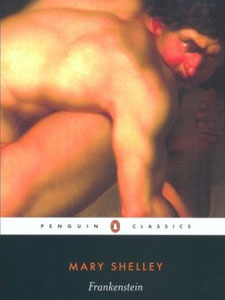| This page is similar in name or subject to other pages.
See also Frankenstein for a complete list of references to clarify differences between these closely named or closely related articles. |
- "I was apparently united by no link to any other being in existence."
- ―Victor Frankenstein
| Frankenstein; or, the Modern Prometheus | |
|---|---|
| Publisher's info | |
| Title: | Frankenstein; or, the Modern Prometheus |
| Author: | Mary Shelley |
| Publisher: | Harding, Mayor & Jones |
| 1st printing: | January 1st, 1818 |
| Page count: | 280 |
| Navigation | |
| Previous: | — |
| Next: | — |
Frankenstein; or, The Modern Prometheus, is a novel written by English author Mary Shelley about eccentric scientist Victor Frankenstein, who creates a grotesque creature in an unorthodox scientific experiment. Shelley started writing the story when she was eighteen, and the novel was published when she was twenty. The first edition was published anonymously in London in 1818. Shelley's name appears on the second edition, published in France in 1823.
Shelley had traveled to Europe, visiting Germany and Switzerland. In 1814, prior to writing the famous novel, Shelley took a journey on the river Rhine in Germany with a stop in Gernsheim which is just 17km (10mi) away from Frankenstein Castle, where two centuries before her visit an alchemist was engaged in experiments. Later, she traveled in the region of Geneva (Switzerland)—where much of the story takes place—and the topics of galvanism and other similar occult ideas were themes of conversation among her companions, particularly her lover and future husband, Percy Shelley. Mary, Percy, Lord Byron, and John Polidori decided to have a competition to see who could write the best horror story. After thinking for days about what her possible storyline could be, Shelley dreamed about a scientist who created life and was horrified by what he had made; her dream later evolved into the story within the novel.
Frankenstein is infused with elements of the Gothic novel and the Romantic movement and is also considered to be one of the earliest examples of science fiction. Brian Aldiss has argued that it should be considered the first true science fiction story, because unlike in previous stories with fantastical elements resembling those of later science fiction, the central character "makes a deliberate decision" and "turns to modern experiments in the laboratory" to achieve fantastic results. It has had a considerable influence across literature and popular culture and spawned a complete genre of horror stories, films, and plays.
Since publication of the novel, the name "Frankenstein" is often used to refer to the monster itself, as is done in the stage adaptation by Peggy Webling. This usage is sometimes considered erroneous, but usage commentators regard the monster sense of "Frankenstein" as well-established and an acceptable usage. In the novel, the monster is identified via words such as "creature", "monster", "fiend", "wretch", "vile insect", "daemon", "being", and "it". Speaking to Victor Frankenstein, the monster refers to himself as "the Adam of your labors", and elsewhere as someone who "would have" been "your Adam", but is instead "your fallen angel." [1]
Appearances[]
- Victor Frankenstein
- Elizabeth Lavenza Frankenstein
- Alphonse Frankenstein
- Caroline Beaufort Frankenstein
- Frankenstein's Monster
- Henry Clerval
- Justine Moritz
- William Frankenstein
- Bride of Frankenstein
- Robert Walton
- De Lacy
- Felix De Lacy
- Saphie
Locales[]
Items[]
Notes & Trivia[]
External Links[]
- Frankenstein at Wikipedia
- Frankenstein at Project Gutenberg
- Frankenstein at My Hideous Progeny
- Mary Wollstonecraft Shelley Chronology & Resource Site
References[]
| This article relates to the Frankenstein franchise. This template will categorize articles that include it in into the Frankenstein media category. |
